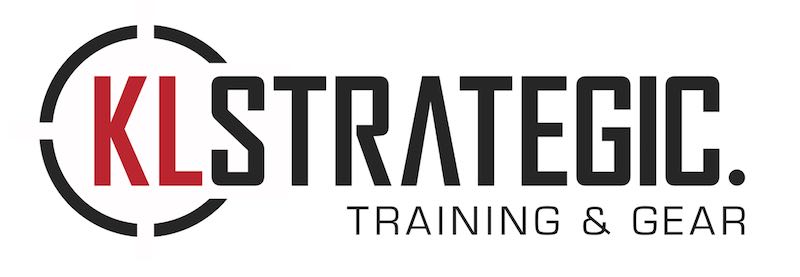Hol Dir den wöchentlichen SPARTANAT-Newsletter.
Dein Bonus: das gratis E-Book von SPARTANAT.
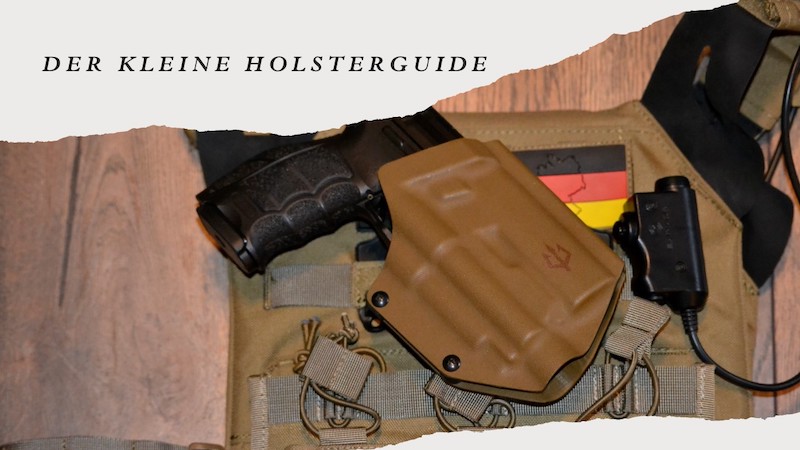
Der kleine Holsterguide – Teil 1
Warum ein Holster-Guide? Was ist so besonders an diesen Teilen, die einfach nur eine Schusswaffe halten sollen?
Warum eigentlich ein Holsterguide? Was ist denn so besonders an diesen Teilen, die einfach nur eine Kurzwaffe halten sollen?
Kurz und knapp gesagt: Alles. Die Wahl des richtigen Holsters für einen Einsatzzweck hat wesentlichen Einfluss auf den Einsatz der Kurzwaffe – egal ob sportlich, jagdlich oder behördlich. KL STRATEGIC führt euch in die Welt der Holster ein und gibt wesentliche Tipps, was ihr beachten müsst.
Wie findet man nun das passende Holster für sich, gibt es doch so viele unterschiedliche Modelle und Formen in so verschiedenen Preisklassen und Materialien … Was eignet sich und was nicht, ist teuer gleich gut, oder reicht auch ein günstiges Modell? Diese und weitere Fragen möchte ich in diesem Artikel klären und euch eine Entscheidungshilfe geben, wie ihr euer passendes Holster findet. Also los geht’s:
Grundsätzlich gilt, dass ihr mit eurem Holster klarkommen müsst – das funktioniert nur mit entsprechendem Training. Egal für welches Holster ihr euch letztendlich entscheidet, es muss euren Bedürfnissen entsprechen und darf euch nicht bei der Ausübung anderer Tätigkeiten behindern.
Hierbei spielen diverse Faktoren wesentliche Rollen und sollten daher im Vorfeld in Betracht gezogen werden, sofern nicht die Vorgaben einer Sportordnung euch bereits in der Wahl einschränken.
Position des Holsters
Wo soll das Holster am Körper positioniert werden? Grundsätzlich sollte das sogenannte „crossdraw“ (Überkreuzziehen, also das Ziehen und Holstern der Waffe auf der der Schusshand abgewandten Körperseite) vermieden werden. Es gibt jedoch gewisse Situationen, in denen dies unvermeintlich ist, um den Zugriff auf die Kurzwaffe schnell und sicher zu ermöglichen. Diese ist zumeist dann der Fall, wenn man sich in einer sitzenden Position in einem beengten Raum befindet – also in einem Fahrzeug. Hier besteht ggf. auch die Möglichkeit des sog. „appendix carry“, sofern Ausstattung oder Ausrüstung dies nicht verhindern. In diesen speziellen Fällen kann es von Vorteil sein, die Waffe auf dem Oberkörper zu platzieren, was zu einer Crossdraw Situation führt. Hier bieten sich dann z.B. Wechselsysteme an, um das Holster von einer Position auf eine andere wechseln zu können.
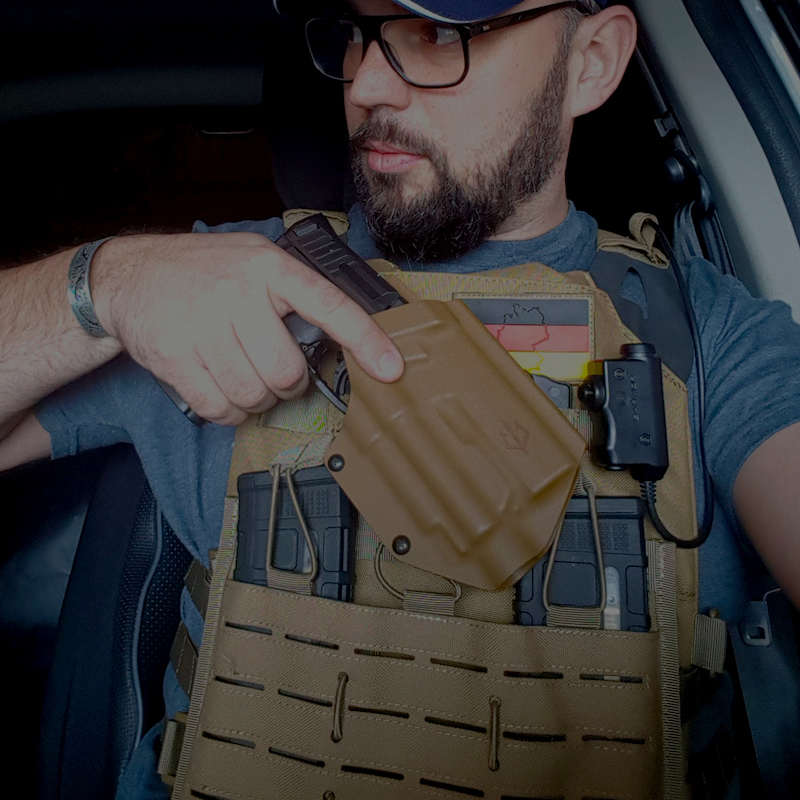
Als Grundsatz sollte man sich jedoch merken, dass ein Holster immer auf der Körperseite positioniert wird, wo sich die Schusshand (die Hand, welche die Waffe führt) befindet. An welcher Position genau, sei zunächst einmal dahingestellt, da hier zusätzliche Faktoren eine Rolle spielen. Die erste Frage ist also:
Holster für Rechts- oder Linkshänder?
Ist diese Frage geklärt, geht es um die Frage, wo das Holster genau platziert werden soll. Die Antwort darauf ist allerdings nicht immer ganz so einfach: OWB oder IWB? Wenn OWB, dann Gürtel, mit Steg, oder doch lieber Dropleg, welche Position am Gürtel? Open oder concealed carry? IWB Appendix carry, oder lieber 3 Uhr Position, oder doch lieber 4 oder 6 Uhr Position???
Die Antworten auf diese Fragen muss jede(r) selber beantworten, aber es gibt Gott sei Dank Anhalte, welche man dabei beachten kann und sollte …
Open vs concealed carry
Diese Frage zu beantworten ist relativ leicht. Sportlich ist „open carry“ (nicht verdecktes Führen) die einzige Option. Weiterhin werden in den jeweiligen Sportordnungen noch weitere Vorgaben für Holster gemacht, sofern überhaupt einer erlaubt ist.
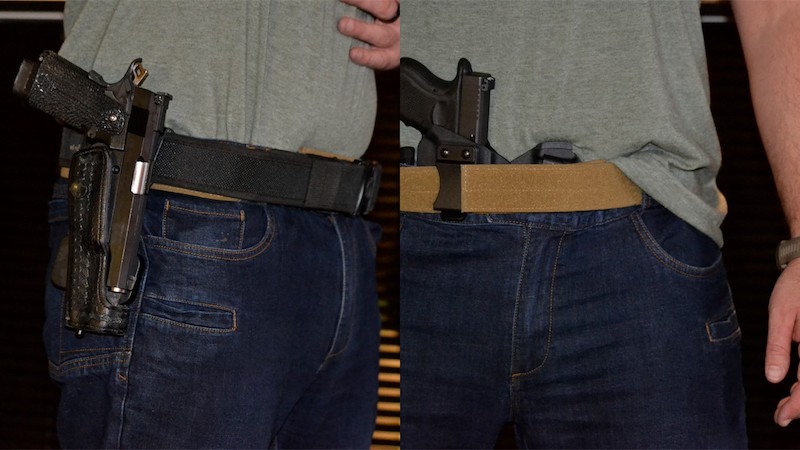
Anders ist es für Jäger oder auch professionelle/behördliche Anwender. Grundsätzlich wird den Behörden vorgegeben, dass Schusswaffen offen zu führen sind und der jeweilige Dienstherr gibt praktischerweise auch gleich das Holster dazu. Insbesondere militärische Anwender müssen die Waffen offen führen.
In gewissen Bereichen wird jedoch freigestellt, was genutzt wird, oder auch wie die Kurzwaffe geführt wird, in speziellen Bereichen ist „concealed carry“ (verdecktes Führen) vorgeschrieben oder sogar zwingend erforderlich. Dies gilt oftmals für den Bereich der bewaffneten Personenschützer zivil und behördlich sowie für ermittelnde Beamte in Zivil, also immer dann, wenn das Führen einer Kurzwaffe nötig ist, aber nicht offensichtlich sein darf. Gründe hierfür können sehr unterschiedlich sein und sollen auch erst einmal nicht interessieren.
Was sind denn nun die Vor- und Nachteile der jeweiligen Trageweise?
Die offene Trageweise bietet einen ganz offensichtlichen Vorteil, nämlich den direkten, ungehinderten Zugriff auf das Holster und ggf. auch die Waffe. Warum ggf.? – Holster bieten verschiedene Sicherungsgrade der Waffe; Level 1-3 sagt etwas über die Sicherung der Waffe im Holster und den Entreiß Schutz aus. Dazu aber später mehr.
Zunächst ist es weniger zeit- und trainingsaufwändig eine Kurzwaffe aus einem offen geführten Holster einzusetzen, als aus einem verdeckt geführten; etwas abhängig von der Position des Holsters am Körper. Naturgemäß liegt dies daran, dass beim concealed carry die Waffe und das Holster i.d.R. von Stoff bedeckt sind, welcher zunächst entfernt werden muss. Wer dies jedoch im Training integriert, ist zumeist nicht wesentlich langsamer beim Einsatz der Waffe als aus einem offen geführten Holster.
Weiterhin kann zusätzliche Ausrüstung das verdeckte Führen behindern oder auch gänzlich ausschließen, indem der Zugriff auf die Waffe erheblich erschwert oder komplett verhindert wird.
In diesen Fällen bleibt die offene Trageweise mit den verschiedenen Optionen (Gürtel, Dropleg) übrig.
Hier muss man also die nächsten Entscheidungen treffen.
In welcher Führsituation soll das Holster genutzt werden?
Um eine entsprechend sinnvolle Entscheidung zu treffen, betrachten wir mal die verschiedenen Führoptionen und Holsterformen …
Open carry
Offen geführt werden Waffen immer dann, wenn sie für Andere sichtbar sind. Wie bereits angesprochen, bietet diese Führart gewisse Vorteile. Der offenkundigste Vorteil ist natürlich der direkte und schnelle Zugriff auf die Waffe, ohne ggf. behindernde Elemente. Hierzu werden verschieden Holsterformen genutzt; vom Schnellziehholster im sportlich-dynamischen Schießen über Formholster am Gürtel bis hin zu Droplegholstern (Oberschenkelholster) zumeist im behördlichen/ militärischen Einsatz.

Man sollte hier klar zwischen dem professionellen (behördliche und zivile Berufswaffenträger) und dem sportlichen Einsatz unterscheiden. Während der sportliche Einsatz eine rein bereitstellende Funktion des Holsters begründet, muss ein Holster im professionellen Einsatz zusätzlich die Funktion der Sicherung der Waffe gewährleisten. Hierzu bieten Hersteller zusätzliche Sicherungen in verschiedenen Geraden an.
Man unterscheidet allgemein zwischen 3 Sicherungslevel:
Level 1: Die Waffe wird durch Klemmwirkung im Holster gehalten, der Abzug ist vor Fremdauslösung gesichert (vom Holstermaterial umschlossen).
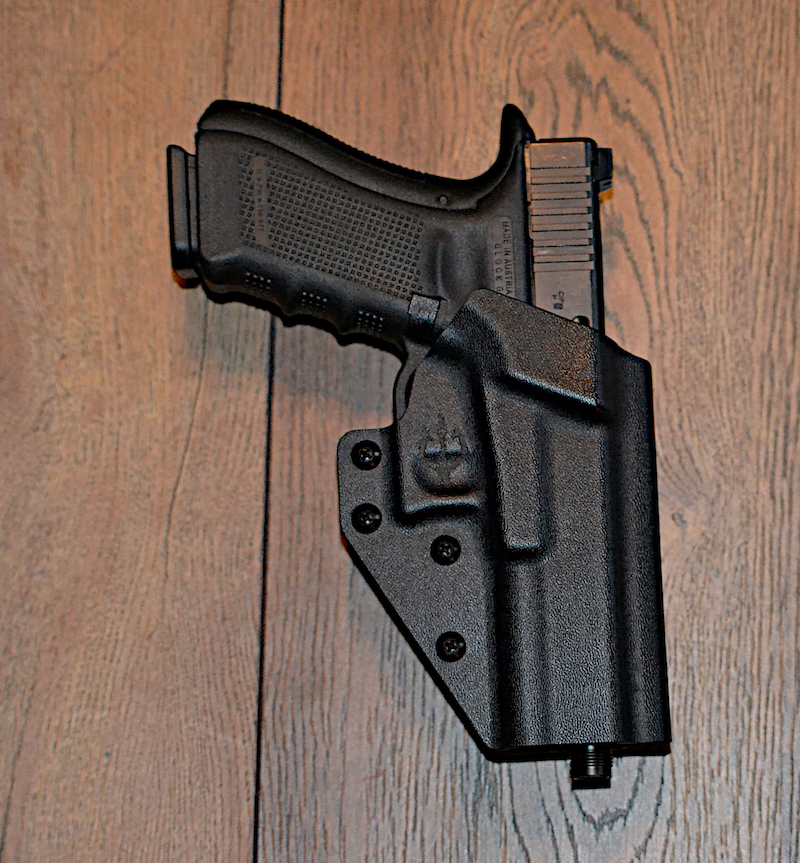
Level 2: Die Waffe wird durch eine separat zu bedienende Sicherung vor dem Entreissen aus dem Holster geschützt. Dies ist i.d.R. ein Bügel oder eine Schlaufe, welche die Waffe im Holster umschließt.
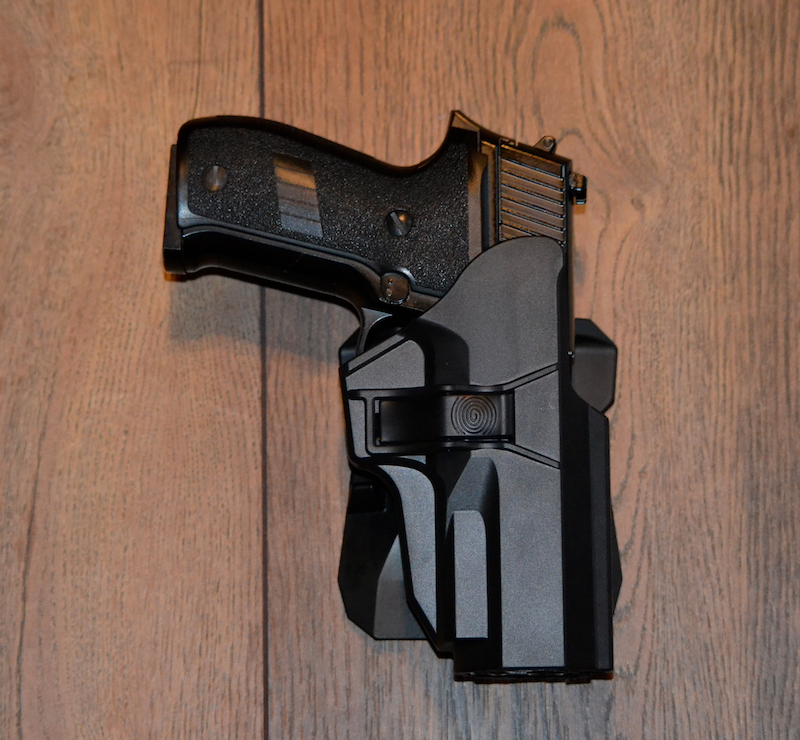
Level 3: Die Waffe wird ergänzend zum Level 2 Schutz im Holster zusätzlich durch eine separat zu bedienende Sicherung gehalten; ggf. werden Level 2 und 3 über eine gemeinsame, separat zu bedienende Sicherung entriegelt.
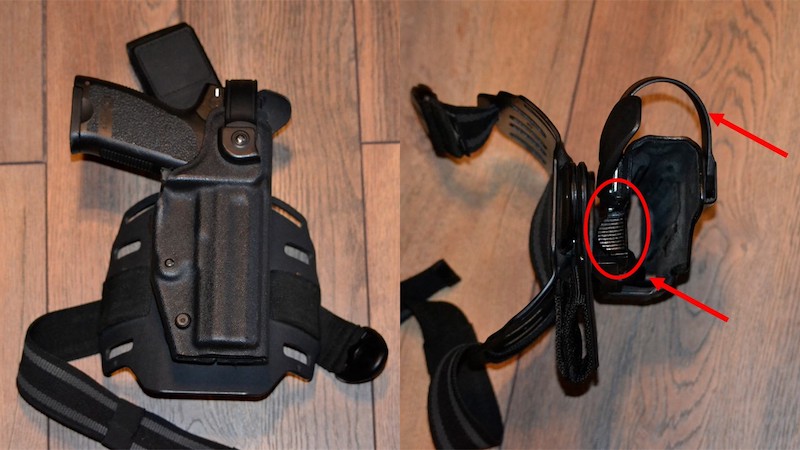
Diese Holster bieten also einen zusätzlichen Schutz der Waffe vor Verlust. Es wäre jedoch ein Trugschluss, zu unterstellen, dass Level 2 oder 3 Holster keinen schnellen Zugriff auf die Waffe ermöglichen; sie sind jedoch deutlich trainingsintensiver als andere Holster. Hat man jedoch die Funktion einmal verinnerlicht, kann die Waffe genauso schnell in den Anschlag gebracht werden, wie aus einem Level 1 Holster.
Eine Sonderform sind die sog. Speed – oder Schnellziehholster. Diese werden ausschließlich im sportlichen Bereich eingesetzt und dienen nur der Bereitstellung der Waffe für den schnellen Zugriff. Hier wird die Waffe i.d.R. lediglich an einem Punkt durch Klemmung fixiert, wobei der Großteil der Waffe nicht vom Holster umschlossen oder gehalten wird. Zwar scheint dies für den besonders schnellen Zugriff von Vorteil zu sein, doch birgt die Nutzung auch deutliche Risiken.
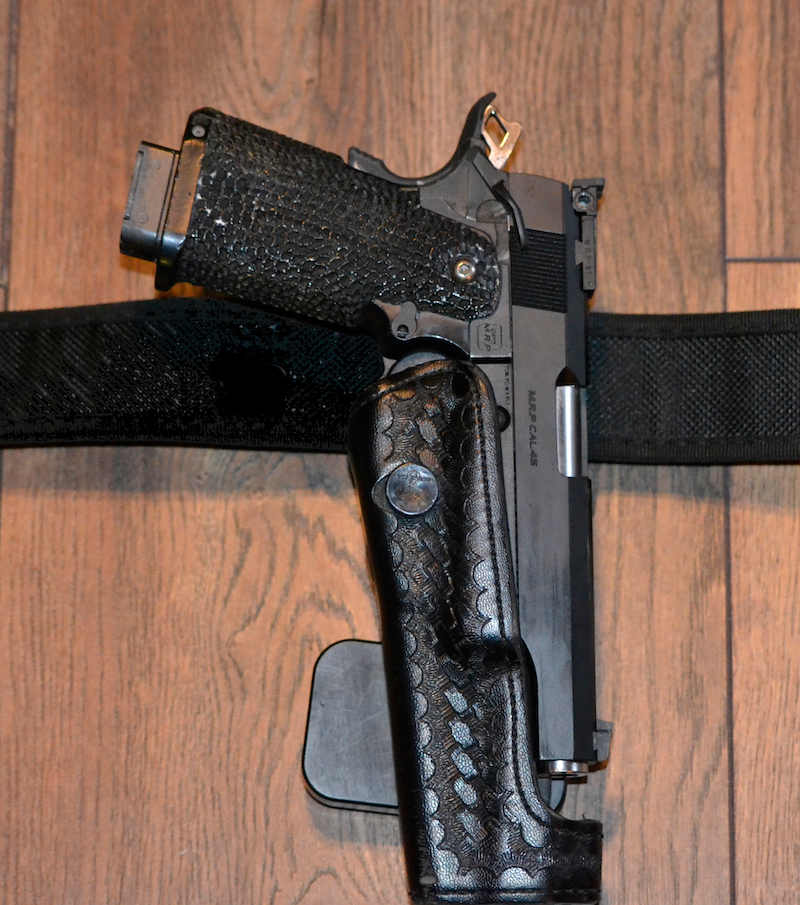
Durch die Klemmung an einem einzigen Punkt ohne (wesentlichen) zusätzlichen Halt steigt das Risiko des Herausfallens aus dem Holster natürlich immens.
Wesentlicher ist jedoch, dass diese Holster reine Profiutensilien sind, die ein wirklich immenses Trainingspensum erfordern, um korrekte Zieh- und Holsterabläufe durchzuführen. Durch den fehlenden Halt tendiert man schnell dazu, die Waffe einfach aus der Keimung zu ziehen und ruiniert sich damit den säubern Ziehvorgang, wodurch die gewonnene Zeit beim Ziehen für eine Anschlagskorrektur oder ein Nachzielen mehrfach vergeudet wird.
Speedholster haben also durchaus ihre Berechtigung, sind aber eher etwas für den echten Spitzensportler als für den Schützen im ambitionierten Breitensport.
Concealed Carry
Das verdeckte Führen (concealed carry) ist genau das, was der Name beschreibt – nämlich das Führen einer Waffe so, dass Außenstehende nicht mitbekommen, dass eine Waffe geführt wird. Dies zu gewährleisten ist nicht so einfach, wie man glauben mag.
Eine Jacke oder ein Hemd über das Holster zu streifen reicht hier bei Weitem nicht aus, geht es doch auch darum bei verschiedenen Bewegungen und Tätigkeiten die Waffe nicht offenzulegen (displaying) oder über verräterische Konturen in der Kleidung (printing) für Andere sichtbar zu machen. Hier bietet sich vor Allem die Variante der IWB (inside the waistband) Holster an, da hierbei schon der Großteil der Waffe innerhalb der Kleidung verdeckt wird; doch auch hier funktioniert dies nicht mit jeder Kleidung und jeder Waffe.
Für das verdeckte Führen gelten zwei „goldene Regeln“:
- Die Waffe muss mit möglichst wenig Aufwand zu Ziehen und wieder zu Holstern sein
Das bedeutet, dass der Zugriff nicht durch unzählige Schichten aus Bekleidung und/oder Ausrüstung erschwert werden darf.
Darüber hinaus und wohl mindestens genauso wichtig ist, dass die Waffe sich weder beim Ziehen, noch beim Holstern im Holster verkeilen darf oder man erst endlos rumstochern und formen muss, um die Waffe aus dem Holster oder wieder hinein zu bekommen. Dies gilt insbesondere für IWB Trageweise.
Was mit Training durchaus möglich ist, ist die Nutzung von Holstern mit einer zusätzlichen Sicherung; dies wird z.B. in verschiedenen Dienstvorschriften für Beamte in Zivil vorgeschrieben.
2. Es darf sich kein Stoff oder sonstiges Material im Holster verfangen
Damit ist insbesondere gemeint, dass sich Bekleidungsstoff oder auch Kordeln, etc. gerne mal in ein Holster, das nicht für das verdeckte Führen geeignet ist, verirrt. Das wiederum verhängt sich beim Holstern im Abzug und schon hat man eine Öffnung im Körper, die besser nicht da wäre. Genau aus diesem Grund haben Holster, die zum körpernahen, verdeckten Führen geeignet sind, eine erhöhte körpernahe Seite, die verhindern soll, dass sich Stoff der Bekleidung ins Holster verirrt. Gleichzeitig dient diese Seite als Führung für die Waffe beim Holstern.
Auf diese Weise wird das Risiko einer ungewollten Schussauslösung um mindestens 50 Prozent reduziert.

Schön und gut, aber wie verhindert man nun Displaying und Printing?
Die Antwort auf diese Frage ist abhängig davon, ob die Waffe IWB oder OWB (outside the waistband) geführt wird. Grundsätzlich sollte zur Vermeidung des Displaying lange und weite Kleidung genutzt werden, i.d.R. mit einer Jacke o.ä. als oberste Schicht. Hierbei sollte man aber darauf achten, dass man einen zügigen Zugriff auf das Holster gewährleisten kann. Wie erfährt man in entsprechenden Kursen.
Wenn man das Holster angelegt hat, sollte man überprüfen, ob dieses bei extremen Bewegungen, als strecken, hocken, etc. verdeckt bleibt. IWB Holster eignen sich hier besser als OWB, könnten jedoch die Bewegungen einschränken. Insbesondere die Spezialform des appendix carry, als das IWB- Führen in der 12 Uhr Position (am Bauch) schränkt ggf. bei Bewegungen ein.
Die sichtbare Bewegungseinschränkung oder -behinderung zählt man auch zum sog. Displaying; auch wenn unbedarfte Personen zwar ggf. nicht erkennen, dass eine Waffe geführt wird, erkennen sie dennoch, dass etwas nicht richtig ist.
Das Abzeichnen von verräterischen Konturen unter der Kleidung (Printing) ist die andere Variante, Anderen zu verraten, dass man eine Schusswaffe führt. Scharfe Kanten, die sich unter der Kleidung abzeichnen, oder Bekleidung, die unnatürlich hängt sind für andere immer ein Zeichen, dass etwas nicht normal ist. Aus diesem Grund sollte man dies beim verdeckten Führen unbedingt vermeiden. Die Form einer Waffe in einem Holster, auch wenn nur teilweise zu sehen, erkennt Jeder.
Wenn dies der Fall ist, kann man die Waffe auch gleich offen führen.
Man will also vermeiden, dass sich Konturen unter der Kleidung abzeichnen; je mehr Stoffschichten über dem Holster liegen, um so eher werden die Konturen verwischt. Gleichzeitig bedeutet aber auch jede Stoffschicht mehr Aufwand beim Zugriff.
Um die Holsterkonturen zu verwischen bietet es sich also an, ein Holster zu nutzen, das möglichst wenig Kanten aufweist, die sich abzeichnen können.
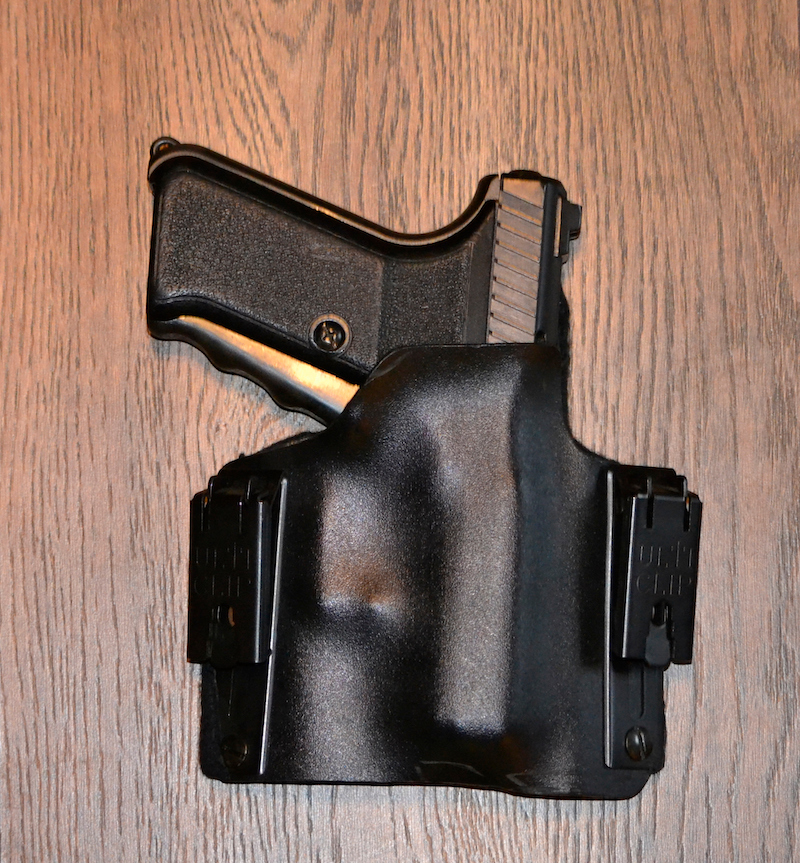
Weiterhin sollte die Waffe im Holster möglichst nah am Körper anliegen und keinesfalls von der Körperkontur anstehen, oder über diese hinausragen. Solche abstehenden Elemente sind kaum mehr zu verdecken. Je nach Positionierung am Körper schränkt dies also auch die Größe der Waffe ein, die geführt werden kann.
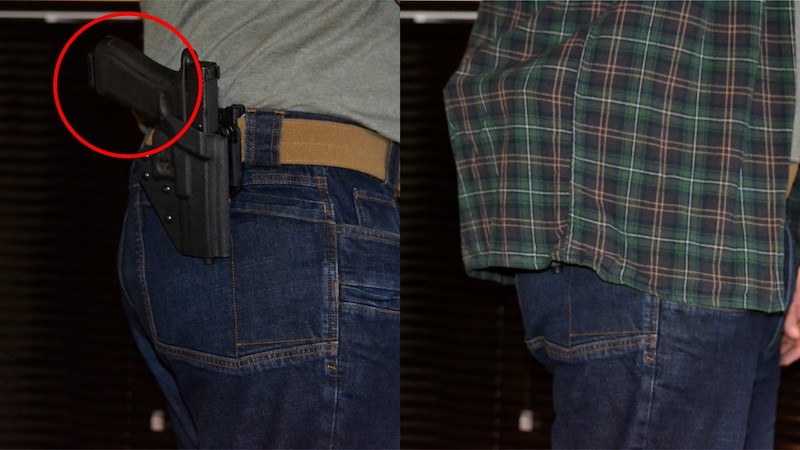

Ein weiterer Tipp ist das Tragen dunkler Farben, da hier eventuell leicht abzeichnende Konturen weniger auffallen, als bei hellen Farben.
Ein Großteil der Holster, die im Artikel zu sehen sind, kommen von der österreichischen Top- Holsterschmiede BLACK TRIDENT. Hier findet ihr 1a Beratung und hochqualitative Holster und mehr: www.blacktrident.com
Aktuelle Kurse 2021, inklusive dem offiziell zertifizierten Ausbilderkurs im Verteidigungsschießen findet ihr bei KL STRATEGIC unter www.kl-strategic.com
KL STRATEGIC im INTERNET: kl-strategic.com
KL STRATEGIC auf FACEBOOK: www.facebook.com/KL-STRATEGIC
SPARTANAT ist das Online-Magazin für Military News, Tactical Life, Gear & Reviews.
Schickt uns eure News: [email protected]
Werbung
Hol Dir den wöchentlichen SPARTANAT-Newsletter.
Dein Bonus: das gratis E-Book von SPARTANAT.


